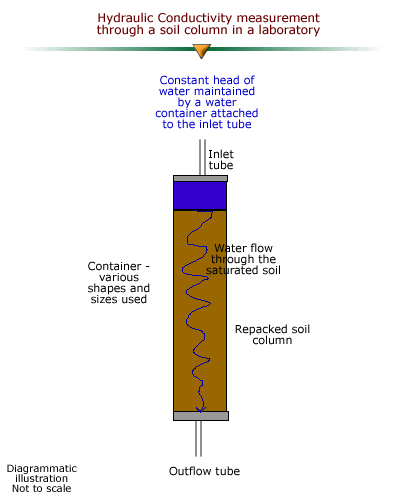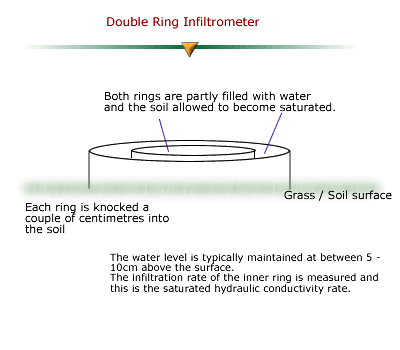What is Hydraulic Conductivity?
In general terms it is the drainage rate of a soil.
More correctly, hydraulic conductivity measures water flow (movement) through the soil, in particular the relative ease of water transmission.
The unit of measurement in turfgrass rootzones is usually in mm per hour. Where gravels are being measured this may be in cm per hour.
What Affects Hydraulic Conductivity?
Hydraulic conductivity depends on several factors:
1. The water content of the soil.
Saturated soils provide for maximum hydraulic conductivity.
As water content decreases the water flow slows considerably, with the transmission of water now taking place around the water film that is 'attached' to soil particles.
2. The arrangement of the pore system (i.e. the continuity of the pores).
Soils which have a continuous system of connected pore spaces will have a higher hydraulic conductivity rate than soils that are compacted or have an inconsistent system of pore spaces. In this latter case water is required to travel in various directions instead of effectively straight down, slowing its downward flow rate.
3. The size of water-filled pores.
Larger water filled pores result in faster hydraulic conductivity rates as it is easier for water to flow through larger pores than smaller ones.
A well structured clay soil, for example, will have a higher rate of hydraulic conductivity than a poorly structured one. Coarse sand will also have a higher rate of hydraulic conductivity than a fine sand.
4. Viscosity (the water's resistance to flow).
Increasing water temperature reduces the viscosity of water and potentially increases hydraulic conductivity. (Essentially, as the water is warmed it moves much easier than when it is cold. It therefore has less resistance to flow, or less viscosity).
Water viscosity is about 50% greater at 5°C than at 20°C, resulting in measured hydraulic conductivity rates being higher in warmer conditions (the summer) than colder ones (the winter).
It is important to ensure that hydraulic conductivity measurements are adjusted to a standardised water temperature to enable objective comparisons to be made between tests. 5°C has been suggested as an appropriate standardised temperature for sports pitches and golf greens.
How is Hydraulic Conductivity Measured?
There is a number of ways that this can be measured, however, two main methods are typically used for turfgrass situations. One is carried out in the laboratory, whilst the other is undertaken on site:
1. Soil is extracted from a site and repacked into a soil column in the laboratory.
Various methods can be used for this laboratory measurement.

As the soil has been moved from the outdoor environment and repacked, it is unlikely to reflect the natural state of the soil. Laboratory tests for sand and soil typically represent unstructured hydraulic conductivity due to the packing that has taken place. (In general a soil or sand will be dried and broken down before packing into a soil column).
Hydraulic conductivity results can vary significantly due to the way samples are handled and packaged prior to reaching a laboratory. This would be particularly pertinent where elements of the existing soil structure were aiming to be retained.
2. A double ring infiltrometer is used in the field.
This is very cumbersome and time consuming, however, it does have the benefit of providing a measured rate that reflects the natural conditions and structure of the soil (or rootzone).

The European Standards Committee (CEN) even has a Technical Committee (TC217) with a project looking into the determination of hydraulic conductivity and water retention.
References and Further Reading
- Russell, E.W. (1973), 'Soil Conditions & Plant Growth', 10th Edn, pp 429-433
- Baker, S.W. (1982), 'The Influence of Water Temperature on the Measurement of Infiltration Rates for Sandy Sports Turf Rootzones', The Journal of the Sports Turf Research Institute, Vol. 58, pp21-27
- Baker, S.W. (1990), 'Sands for Sports Turf Construction and Maintenance', pp15
- Adams, W.A. & Gibbs, R.J. (1994), 'Natural Turf for Sport and Amenity: Science and Practice', pp18-19
- Rowell, D.L. (1994), 'Soil Science: Methods & Applications', pp85-86, 99-107
- Stewart, V.I. (1994), 'Sports Turf Science, Construction and Maintenance', pp57-64, 109-121
- Baker, S.W. et al (2000), 'Laboratory testing of rootzone mixes for sports turf: factors influencing variation in the measurement of soil physical properties', Journal of Turfgrass Science, Vol. 76, pp78-89
